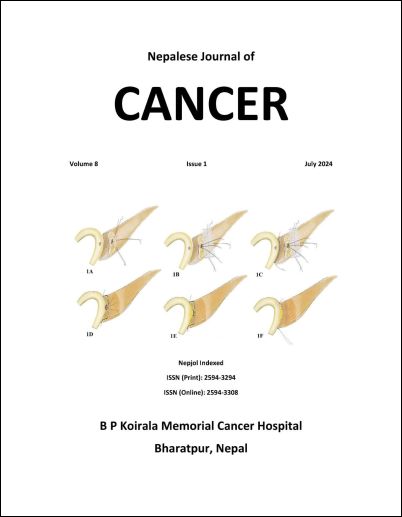Pattern of Clinical Presentation, Staging and Surgical Treatment of Lung cancer in 250 Consecutive Patients.
DOI:
https://doi.org/10.3126/njc.v8i1.68239Keywords:
ung cancer, squamous cell cancer, lobectomyAbstract
Introduction: GLOBOCAN 2022 showed lung cancer to be leading cancer in Nepal accounting for about 11% (2431) of all new cancer cases and about 15% (2207) of all cancer deaths. We reviewed the pattern, clinical presentation, stage and multimodality treatment of lung cancer results in Nepal.
Methods: Two hundred fifty consecutive patients with clinical stages of I-IIIA, who were considered for lung resectional surgery were studied. Bronchoscopy and Computed Tomography were used for diagnosis and staging.
Results: Surgery alone was done in 36% cases, rest of the patients (64%) underwent multimodality approach. Lobectomy, bilobectomy, pneumonectomy, sub lobar resection and sleeve resection were done in 85.6%, 4%, 6.4%, 2% and 2% respectively. Final histology revealed squamous cell carcinoma, adeno carcinoma, and others in 72.4%, 18.4%, 9.2% respectively. Final pathological report showed stage I, II, and III in 14.8%, 30% and 55.2% cases. Thirty-day mortality was observed in 1.6% of cases. Air leak was most common post operative complication (8.4%).
Conclusion: Squamous cell carcinoma still remains the commonest pathological variant of lung cancer in Nepal. Lobectomy remains the most commonly performed surgical procedure
Downloads
Downloads
Published
How to Cite
Issue
Section
License
Copyright (c) 2024 Nepalese Journal of Cancer

This work is licensed under a Creative Commons Attribution 4.0 International License.
This license lets others distribute, remix, tweak, and build upon your work, even commercially, as long as NJC and the authors are acknowledged.
Submission of the manuscript means that the authors agree to assign exclusive copyright to NJC. The aim of NJC is to increase the visibility and ease of use of open access scientific and scholarly articles thereby promoting their increased usage and impact.




